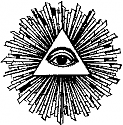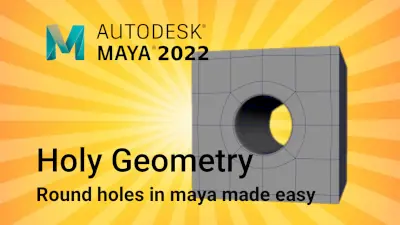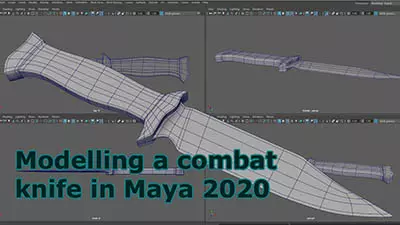Introduction to Maya - Modeling Fundamentals Vol 2
This course will look in the fundamentals of modeling in Maya with an emphasis on creating good topology. It's aimed at people that have some modeling experience in Maya but are having trouble with
complex objects.
#
16
17-12-2009
, 07:44 PM
Nah, I never really fiddle with changing the "per span # of iso params" to anything other then 1 in U and 1 in V so that it matches the number of cv's in my profile curves. I rarely have need to have more the 1 span in the V direction.
Even when I use this to convert nurbs to poly surfaces I tend to rebuild the nurbs surface with the number of spans in U and V that I want in my polygon surface and then once again convert from nurbs to polygon using general, quad, and 1 for per span # of iso parms in U and V.
I did not spend a lot of time editing the video and I did the narration in a single take just off the top of my head. So I hope you are okay with me sputtering and having occasional points where I had brain lock.
Overall how did you like the video? I am thinking of trying to make more of these if folks find 'em useful. Not sure I am the best of voice talent though. Need to work on my British accent so I can say "Chamfer" and "Al-U-Minium" alot! (smile)
If I get good enough at it I might take a stab at doing a full on modeling tutorial.
"If I have seen further it is by standing on the shoulders of giants." Sir Isaac Newton, 1675
#
17
17-12-2009
, 07:45 PM
EduSciVis-er
Join Date: Dec 2005
Join Date: Dec 2005
Location: Toronto
Posts: 3,374
In the inner workings, it's probably more due to something like how it sets up arrays containing edge nodes.

#
18
17-12-2009
, 07:53 PM
Yes, Stewart is correct. When bridging more then a single pair of edges Maya has to make an educated guess as to how to match the edges and more times then not it chooses poorly (smile).
Not to worry though I pointed it out two times in the video when it happened. Watch the part where I bridge the top cap of the top section and the part where I use "bridge faces" to make the hole in the surface on the top section. Both are in part 1. I record at 2x clip speed so things go by quickly but I figure it's easy to rewind and single step and that is preferable to listening to me chatter on for twice as long at normal speed (smile).
All you have to do is go to the history node for the bridge in the channel box and spin the "bridge offset" parameter until all the edges are paired correctly. Sometimes you have to spin this value to a very high number but it will always eventually line everything up correctly.
"If I have seen further it is by standing on the shoulders of giants." Sir Isaac Newton, 1675
Last edited by ctbram; 17-12-2009 at 07:59 PM.
#
19
17-12-2009
, 07:55 PM
Registered User
Join Date: Dec 2009
Join Date: Dec 2009
Posts: 15
the tutorial was perfect. i had no issues following and i got going pretty smoothly.
i've watched many tutorials, and having a voice walk through is crucial. it makes things so much easier.
i look forward to anymore you have coming. maybe i can egg you on with more questions as i develop

#
20
17-12-2009
, 08:14 PM
Way back in maya 3 when I started nurbs modeling was the hotness and I spent a lot of time learning to model using curves and nurbs surfaces.
If there was a single word that was the key to the entire universe of using curves and surfaces in Maya it would be "REBUILD", with uniform distribution and 0 to number of spans for uniform curve and surface parameterization.
This one thing "I believe" is the reason so many people get frustrated with nurbs modeling in maya. Having the cv's normalized parametrically (a fancy way of say being numbered in equal integer intervals, i.e. 0,1,2,3...) is critical, essential, imperative, ..., when doing anything with nurbs and curves in maya.
Having non-uniform parameterization will crash fillets, joins, trims, you name it! Before you do any nurbs operation or when in doubt rebuild! AFTER you complete joins rebuild. Follow these two rules and you will have a lot less headaches with curves and surfaces in maya.
"If I have seen further it is by standing on the shoulders of giants." Sir Isaac Newton, 1675
#
21
17-12-2009
, 08:42 PM
Registered User
Join Date: Dec 2009
Join Date: Dec 2009
Posts: 15
so.... rebuilding with curvature, thats purely to create the minimum number of CV's right?
what if you forget to do that, but still rebuild it uniformly?
also, at around 9.47 in the tutorial 1... you talk about curve snapping.
if i understand correctly, you are moving that face to match the same Y level as the curve next to it right? now, i still couldn't figure it out. you say press the C key. i changed my mapping, so the C button does something else. however, the curve snapping button is at the top, and i selected it, and moving the selected edges in the Y direction did not snap it to any curves. this has never worked for me.
in your tutorial, i never saw the curve snapping icon pressed, so im not sure what the C key actually did.....
this is one part about maya i never figured out.
thanks
#
22
17-12-2009
, 10:05 PM
Rebuilding uniformly is important because it ensures that the parameterization (which is a complicated topic) but in simple terms it has to do with the way maya keeps track of cv's internally is normalized, which affect nearly all operations on curves and surfaces. So it is always a good idea to rebuild before using the tools. It is so important that it is one of the very few things I actually dedicate a hot key for. Both rebuild curve and surface.
Ah yes I thought I did a poor job of describing curve snapping. It goes by so fast hard to spit out all the steps before the video is over.
There are three kinds of snapping that I use alot -
Curve (c), grid (x) and vertex (v)
They all work the same.
1. You first select component(s) - verts, edges, faces...
2. then press and hold c for curve, x for grid, or v for vertex snapping (there are icons at the top of the gui for these as well
3. now if you select the y-handle of the move control all movement is constrained to the y-axis, if you select the other handles movement is constrained to their respective axis as well.
4. finally for curve snap, still holding the c key just press the middle mouse button while gesturing over any curve(edge) and all the selected components will snap to the y-value of a point at which you gesture over on that edge.
So in the video I used it to move all the verts on three of four edges to the same y-value of the curve I middle mouse clicked on.
If you hold the v key you press the middle mouse button while gesturing over a vertex
If you hold the x key you press the middle mouse button while gesturing over a grid line
**************************************
THIS IS REALLY IMPORTANT and it's the reason this snapping is hard to describe. You cannot just middle mouse click on an edge you have to middle mouse click AND drag (what I call gesture) over the curve, grid, or vertex for it to work.
***************************************
Two additional notes.
1. You don't have to first constrain the movement by pressing one of the move control handles. In this case all the selected components will snap directly to what you middle mouse gesture over. If you had vertices selected they would all stack to a single point (which is not very useful).
2. There are 2 options that can get you borked if you don't check it. In the move options (double click the move selection icon or press the left mouse button while holding the w key) and be sure "world" is checked (all this snapping stuff only works right in world mode) and the other box is "keep spacing" in most cases I have this box UNCHECKED. If checked the components move but keep their RELATIVE spacing.
One place grid (x) snapping is useful is when you want to move all the verts along the centerline of an object so their x coordinate is at zero. This is important when mirroring objects. You select all the verts, make sure move options is in "world" mode and the "keep spacing" box is UNCHECKED, press and hold the x key, then press the middle mouse button while gesturing over the origin [0,0,0] on the grid and all the verts will .... snap on top of each other to [0,0,0] ...
JUST CHECKING TO SEE IF YOU WERE PAYING ATTENTION....
You have to click the X-handle on the move manipulator to constraint all the points to only move along the x-axis, then press and hold x key, then middle mouse gesture over the [0 0 0] origin on the grid and all the verts will only move to 0 in their x-coordinate and will be aligned on the origin.
"If I have seen further it is by standing on the shoulders of giants." Sir Isaac Newton, 1675
Last edited by ctbram; 17-12-2009 at 10:13 PM.
#
23
20-12-2009
, 10:53 PM
Registered User
Join Date: Dec 2009
Join Date: Dec 2009
Posts: 15
i figured out what the issue with the snapping was.
if i want to move a face, i select the face. i then go into curve snapping mode.
gesturing over an edge while middle-click didn't do anything because i had to get out of face mode and go into edge mode.
then, i can middle click + gesture of the edge i want.
slightly unintuitive... since by definition, curve snapping should know i want to snap to anything that is a curve.
also, concerning the "retain component spacing" the help file says :
"Turned on by default. This means that while Maya moves the component, relative spacing is maintained. Turn this option off if you don’t want to preserve relative spacing while translating and snapping polygonal components. "
this is still unclear, since when turned on and off, the result was exactly the same. referring to your tutorial, if i snap the face to the edge, then what relative space would be maintained, the space between the face and the edge? the face moves and the edge stays, so i don't see how anything is maintained.
indeed!
#
24
21-12-2009
, 01:13 AM
Registered User
Join Date: Dec 2009
Join Date: Dec 2009
Posts: 15
you recommended building curves for curvature first, THEN for unison.
i noticed that when i rebuild my curve for curvature, the shape of the curve changes and is no longer matching as shown from the before and after.... i verified my settings for the rebuild for curvature were identical to yours on the video.
any ideas why this might be occurring?
thanks
#
25
21-12-2009
, 04:54 PM
Can you post two images so I can see the change?
I usually rebuild with "curvature" then "uniform".
Rebuilding with curvature gives me an idea of the number of cv's to rebuild uniformly with and fixes a bug in maya where sometimes the curve goes all wonky when rebuilding directly to uniform distribution.
"If I have seen further it is by standing on the shoulders of giants." Sir Isaac Newton, 1675
Last edited by ctbram; 21-12-2009 at 05:09 PM.
#
26
21-12-2009
, 10:25 PM
Registered User
Join Date: Dec 2009
Join Date: Dec 2009
Posts: 15
let me know if you still don't see it
#
27
22-12-2009
, 06:40 PM
Yeah, that happens sometimes and I really cannot explain why. There are very few cv's in the original curve. But I was not able to duplicate it, so a small number of cv's does not seem to be at issue.
When that happens I usually just manually recreate the original curve and that usually fixes it.
Maya nurbs tools have always been a little squirely. I still find them more easy to use then b-splines of other packages though. I really hope autodesk will revamp them and perhaps bring the more robust and "reliable" tools from what used to be studio tools into Maya.
"If I have seen further it is by standing on the shoulders of giants." Sir Isaac Newton, 1675
#
28
22-12-2009
, 08:49 PM
anyway, with the curve thing, wouldn't freezing the transforms and deleting the history before you rebuild the curve, fix that?
#
29
22-12-2009
, 11:29 PM
Just a heads up, sometimes rebuilding manually is the ONLY fix so don't get to wrapped around the axle fighting it.
It's definitely an internal thing because the only way I know to ALWAYS fix this kind of problem was to export in a format the Autodesk in their infinite stupidity took out of Maya so now you cannot fix it PERIOD without just starting over and building the patch manually from scratch (sigh).
I forget what the export format was but when autoedesk took over Maya they removed it. If you find some old Gnomon nurbs modeling tutorials it's one of the first things they show you - the problem and then the fix export and re-import the model in the magic format and poof the curves rebuild properly.
I guess since nurbs have fallen out of favor that no one at autodesk or alias before them felt it was worth putting any effort in to fix.
"If I have seen further it is by standing on the shoulders of giants." Sir Isaac Newton, 1675
Last edited by ctbram; 22-12-2009 at 11:31 PM.
Posting Rules Forum Rules
Similar Threads
Recurring issue with edge loops
by Banankakan in forum Maya Basics & Newbie Lounge replies 4 on 29-05-2019
Reproducible 2016.5 nCache missing frame issue
by stwert in forum Dynamics & Special Effects replies 1 on 12-09-2016
ElektroBot Making document - Sait Bakırcı
by saitbakirci in forum SimplyMaya Tutorials replies 0 on 07-06-2012
Polygon Face Modeling for Beginners
by LadySekhmet in forum Maya Basics & Newbie Lounge replies 2 on 12-03-2009
Topics
Free Courses
Full Courses
VFX News
How computer animation was used 30 years ago to make a Roger Rabbit short
On 2022-07-18 14:30:13
Sneak peek at Houdini 19.5
On 2022-07-18 14:17:59
VFX Breakdown The Man Who Fell To Earth
On 2022-07-15 13:14:36
Resident Evil - Teaser Trailer
On 2022-05-13 13:52:25
New cloud modeling nodes for Bifrost
On 2022-05-02 20:24:13
MPC Showreel 2022
On 2022-04-13 16:02:13









